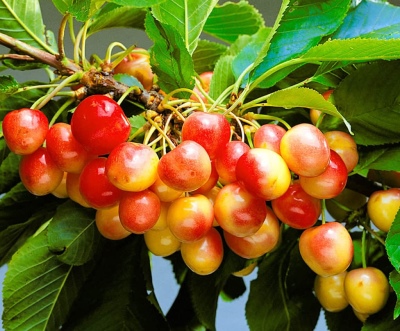
- Pruning: held in spring from 3-5 years of age
- Fruit shape: classic rounded
- Growth type: undersized
- Appointment: universal
- Yield: high
- Tree height, m: 2–3
- Crown: wide-round, thick
- Fruit size: large
- Fruit weight, g: 5-6
- Fruit color: golden with scarlet blush
Sweet cherry is a tree that grows in almost every summer cottage, since it is easy to grow, the main thing is to choose a variety that easily adapts to the climate of the region. Cherry Krasnaya Gorka of domestic selection is considered a reliable and tasty variety.
Breeding history
Krasnaya Gorka is the brainchild of the famous breeder M.V. Kanshina. The fruit and stone fruit culture was bred at the All-Russian Research Institute of Lupine (Bryansk) in 2001. The parental forms are the cherry varieties Compact Venyaminova and Leningradskaya Black. Recommended for cultivation in the Central region.
Description of the variety
The red hill is a weakly growing tree endowed with a raised, wide-round crown shape with a strong thickening of light green leaves. Under favorable conditions, cherries grow up to 2-3 meters in height. The tree is characterized by a horizontal root system, a whorled arrangement of branches and elongated buds, located deviating from the shoots.
Cherry blossoms in the first decade of May. At this time, the neat crown is simply strewn with pale pink five-petal flowers, which emit a sweetish aroma. The formation of ovaries occurs on bouquet twigs and annual shoots.
Fruit characteristics
Sweet cherries, beautifully collected in bunches, belong to the large-fruited category. On average, the berries gain a weight of about 6 grams. Cherries have a regular rounded shape with a smooth and glossy surface. Ripe berries have a special color - the golden cover is diluted with a light scarlet blush, covering more than half of the fruit. The peel of the cherry is thin, elastic, without subcutaneous points and spots. The abdominal suture is thin, almost invisible.
From the stalk, the berry comes off semi-dry, sometimes damaging the skin. That is why it is not recommended to transport cherries over long distances. You can store the berries for some time in a cool place - up to 2-3 days. The use of berries is universal - they are eaten fresh, they are widely used in cooking (filling for pies, compotes, sweet sauces, decorative elements). The variety is not suitable for making jams and jams, since the delicate berry quickly boils down.
Taste qualities
Golden scarlet cherries are delicious. The transparent pulp of the berries is characterized by a fleshy, dense, tender and very juicy texture. The taste is balanced - sweetish with a pleasant sourness, complemented by a dessert aftertaste. The small bone is easily separated from the pulp.
Ripening and fruiting
The red hill is an early maturing variety. The tree begins to bear fruit in the 4th year after planting. The fruits are ripened unevenly. The period of active ripening of berries falls on the end of June - mid-July. You need to remove ripe cherries right away, otherwise they will become bird food. Abundant fruiting in a tree is observed from the age of 6 to 12 years. Further, the yield at the tree gradually decreases.

Yield
The yield indicator of the variety is high. Providing the necessary agricultural technology, about 45 kg of berries can be harvested from one tree.
Self-fertility and the need for pollinators
Sweet cherry is self-fertile, therefore it needs cross-pollination. For productive pollination, it is recommended to plant several donor trees at a distance of 2-3 meters. Cherries are considered the best pollinators: Bryanskaya pink, Ovstuzhenka, Raditsa.
Growing and care
Planting a seedling can be done in spring or autumn. For planting, a flat area is chosen, where a lot of the sun gets, but there is protection from strong winds and drafts. The south side of the garden is ideal. A good neighbor planting for cherries on Krasnaya Gorka will be a cherry tree.
This variety is unpretentious in care, but there are a number of vital measures - watering (not at the root, but in the periosteal groove), top dressing from the second year of life (early spring, summer, autumn), weeding and loosening the soil, spring pruning of branches from the third year life, crown molding, disease prevention and protection for the winter. Whitewashing, which is carried out in late autumn, will help to avoid sunburn in hot summer. You can protect the rhizome by covering the near-stem zone with spruce branches.




Disease and pest resistance
The immunity of this species is good. The tree is resistant to moniliosis and perforated spotting, and is also rarely attacked by pests. In addition, sweet cherries are moderately resistant to coccomycosis.

Requirements for soil and climatic conditions
Krasnaya Gorka is the owner of high frost resistance, withstanding temperature drops down to –30… 33 degrees. The tree loves the sun, light and warmth. The culture grows comfortably on fertile, nutritious, air / moisture-permeable soils with low acidity. It is important that the flow of groundwater is deep, otherwise moisture stagnation will disrupt the vital activity of the root system. The best for cherries will be loam and sandy loam.
































































